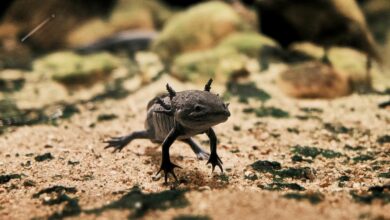Can Sharks Change Their Color?
Great White Sharks may change their color to sneak up on prey.
While growing up in a coastal town, Johnson, a native of New Zealand, learned the conventional wisdom that dolphins were “the nice guys” and sharks were “the bad guys.” When he was 20, he wanted to work with dolphins, so he opted to study marine biology. He had the chance to conduct some research on the behavior of the great white sharks in South Africa. Overfishing was putting a lot of strain on these animals at the time, which resulted in an increase in shark attacks.
Based on his fieldwork, Johnson had long suspected that great white sharks might be able to change their color. Shark biologists use dorsal fins, scars, and other distinctive features to differentiate certain sharks. He noted how frequently he and his colleagues would see a light-colored shark in the morning and another shark with a darker color in the afternoon and would assume they were two different creatures.
color. Shark biologists use dorsal fins, scars, and other distinctive features to differentiate certain sharks. He noted how frequently he and his colleagues would see a light-colored shark in the morning and another shark with a darker color in the afternoon and would assume they were two different creatures.
Then he met with Gibbs Kuguru, a blacktip shark researcher doing Ph.D. research on color changes in the Maldives. “What if I told you that great white sharks can also alter their color?” asked Johnson. Kuguru thought the concept was interesting, so they began looking into it. They discovered cases of hammerhead sharks lying in the sun and particular rays that could alter their color.
A pretty exciting finding of the great white shark
Johnson states, “We realized this was a new area of shark research, and it could be important in explaining how they fit into the environment. “Like everyone else, I had observed their jaws and bite strength. But here was this incredibly subtle behavioral adaptation, which, in my opinion, is important for great white sharks and maybe a lot more sharks.”
how they fit into the environment. “Like everyone else, I had observed their jaws and bite strength. But here was this incredibly subtle behavioral adaptation, which, in my opinion, is important for great white sharks and maybe a lot more sharks.”
Nothing in the scientific literature suggests that great whites can change color, which has motivated Johnson and Kuguru to keep studying the phenomenon.
The first step was finding evidence that great white sharks could truly change color. This was a difficult task because it required comparing images of different sharks. Perception of color can be influenced by various things, including lighting, weather, a lack of a relevant frame of reference, and the sort of camera used.
“What excited me about this research was that we wanted to look into something incredibly subtle and microscopic,” says Ryan Johnson, a shark biologist at the Blue Wilderness Shark Research Unit in South Africa and Kuguru’s research partner.
Unwinding the secrets of the great white shark
In experiments off South Africa, researchers pulled a seal decoy behind a boat to get several sharks to surface near a specially made color board with white, gray, and black panels. Every time a shark jumped out of the water, a photo was taken and using the color cards as a guide, the images were adjusted to weather, light, and camera settings. The experiment was repeated throughout the day, with the researchers taking pictures of the sharks each time they jumped.
As Johnson and Uguru looked through the images, one shark, in particular, stood out because it had a very noticeable abscess on its jaw. This shark appeared in the photographs at different times of the day as dark gray and lighter gray.
Their research had convinced the pair that a great white shark’s hormonal regulatory mechanism is possibly connected to the animal’s behavior, and the environment might be responsible for color change. “In my opinion, if it did happen, it would either be hormonally regulated or may involve sunbathing,” said Johnson.
Johnson and Kuguru had to figure out a way to extract living cells from great white sharks in the field and then rush those cells to a nearby lab for testing. It was an intense two hours. “I was laughing and delighted on the boat, but I was also saying, ‘Gibbs, get the dang sample because we have got to go,'” Johnson said.
The researchers were then able to see and film how the tremendous white melanocytes’ skin cells that carry pigment contracted and lightened in color when bathed in adrenaline by examining tiny skin samples under a microscope. The same cells were also spread out simultaneously by a different hormone called melanocyte-stimulating hormone (MSH), which led to darker skin tone.
“Some little sharks may adapt their color to the environment,” said Johnson. “They get lighter if they are against a light background. And if they’re in a dark background, they go darker. That could be the case with the great white. When the shark is hunting seals at the surface, it should go darker to absorb as much light as possible. And when it’s down deep, it should go lighter.
These preliminary results are a promising first step. Gregory Skomal, a shark expert and head of the Massachusetts Shark Research Program, claims he, too, is not entirely shocked by the preliminary research. However, he’d like to see them supported by a more formal scientific study. “We know many species of fish are capable of changing their color tones,” says Skomal. “So I think it’s a pretty exciting finding.”
The researchers caution that their research has not been published in a scientific journal and that the great white’s ability to change its appearance has not yet been confirmed based on data from a small number of sharks. Other experts, though, claim that the possibilities are intriguing.
“So we tested it, and not only did it work, but it was a swinging success,” says Kuguru.
The researchers hope that by studying a more extensive data set, they can confirm that the color change they have observed is not an accident but also uncover a pattern of when and why the animals enter camouflage mode.





